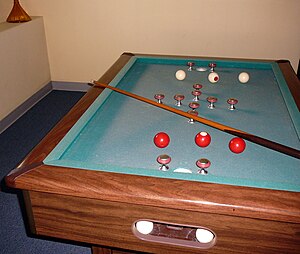Bumper pool: Difference between revisions
SMcCandlish (talk | contribs) m Linking to an offsite article on every possible meaning of the word "forfeit" doesn't do anything to disambiguate. |
Aarondoucett (talk | contribs) No edit summary |
||
| Line 1: | Line 1: | ||
{{Copyedit|date=December 2007}}<!--"You" wording and other problems. Low priority for [[WP:CUE]], but we may get around to it eventually.--> |
{{Copyedit|date=December 2007}}<!--"You" wording and other problems. Low priority for [[WP:CUE]], but we may get around to it eventually.--> |
||
'''Bumper pool''' is a [[billiards]] game played casually on an [[Octagon|octagonal]] (or, uncommonly, [[Rectangle|rectangular]]) table with one pocket centered on each end. Most tables have 12 bumpers, although some tables have 14 or 16. Two bumpers surround each pocket with the other eight arranged on the table's midlines leaving a center space just large enough for a ball to pass through. Tables with 14 bumpers have three rather than two bumpers on each side of the center space on the line midway between the two holes. The game is played with 5 red and 5 white [[Billiard ball|balls]], with one marked ball in each set. The game may be played in a much smaller room than most billiards games because the tables are much smaller. This type of billiards is mostly played in [[France]].{{Dubious|date=December 2007}} |
'''Bumper pool''' is a [[billiards]] game played casually on an [[Octagon|octagonal]] (or, uncommonly, [[Rectangle|rectangular]]) table with one pocket centered on each end. Most tables have 12 bumpers, although some tables have 14 or 16. Two bumpers surround each pocket with the other eight arranged on the table's midlines leaving a center space just large enough for a ball to pass through. Tables with 14 bumpers have three rather than two bumpers on each side of the center space on the line midway between the two holes. The game is played with 5 red and 5 white [[Billiard ball|balls]], with one marked ball in each set. The game may be played in a much smaller room than most billiards games because the tables are much smaller. This type of billiards is mostly played in [[France]].{{Dubious|date=December 2007}} |
||
[[File:Bumper_pool_table.jpg|left|thumb|300px|Rectangular bumper pool table]] |
|||
== Gameplay == |
== Gameplay == |
||
Revision as of 22:40, 10 May 2009
This article may require copy editing for grammar, style, cohesion, tone, or spelling. (December 2007) |
Bumper pool is a billiards game played casually on an octagonal (or, uncommonly, rectangular) table with one pocket centered on each end. Most tables have 12 bumpers, although some tables have 14 or 16. Two bumpers surround each pocket with the other eight arranged on the table's midlines leaving a center space just large enough for a ball to pass through. Tables with 14 bumpers have three rather than two bumpers on each side of the center space on the line midway between the two holes. The game is played with 5 red and 5 white balls, with one marked ball in each set. The game may be played in a much smaller room than most billiards games because the tables are much smaller. This type of billiards is mostly played in France.[dubious – discuss]

Gameplay
Each set of balls is arranged on five spots near each edge of the table by a pocket with the marked ball directly in front of the pocket. Both players shoot their marked ball attempting to sink the ball in the pocket at the other end of the table. The shooter must bank the ball off the cushion to his right. After this initial shot players alternate (the player whose first shot ends up nearest the pocket shoots first). If both players sink their first shot they each select another ball, place it in front of the pocket, and repeat the simultaneous shot. If all five balls are simultaneously sunk in this fashion the game is a draw. The object is to sink all your balls into the pocket at the opposite end of the table. Unlike other billiard games, there is no designated cue ball; each ball can be shot into the pocket. A player's marked ball must be sunk before the player can shoot any other balls. A player's turn continues until no ball is sunk.
Fouls
If a player sinks one of the opponent's balls there is no penalty. However, the ball is considered sunk regardless of which pocket it drops in. If a player sinks one of his own balls (but not the last) in the wrong pocket, the opponent may drop two balls into his pocket. Sinking your last ball in the wrong pocket results in a forfeit. A ball that leaves the table is placed anywhere on the table by the opponent, usually in the middle space surrounded by bumpers. Under some sets of rules, the opponent may additionally drop two balls into his pocket.[clarification needed]

